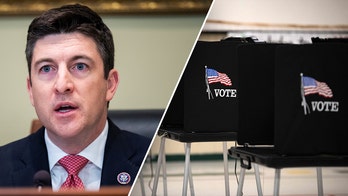States to watch Election Night Trump or Biden need to win
Tom Bevan, RealClearPolitics co-founder, and Jim Messina, former WH deputy chief of staff, weigh in on 'The Daily Briefing.'
On Election eve, President Trump faces challenging poll numbers but remains confident of pulling off a second straight come-from-behind victory.
“We're going to win four more great years in the White House,” Trump predicted as he spoke to supporters in Georgia on Sunday night.
The latest national public opinion polls appear to tell a different story. But it's a much closer contest in the key battleground states that will decide the White House winner.
WHAT THE FINAL FOX NEWS NATIONAL POLL SHOWS IN THE BIDEN-TRUMP SHOWDOWN
An NBC News/Wall Street Journal national poll conducted Thursday through Saturday indicated Democratic presidential nominee Joe Biden holding a 10-point (52%-46%) lead over Trump while a Quinnpiac University poll conducted Wednesday through Sunday showed Biden up by 11-points (50%-39%). But a survey conducted for Investor’s Business Daily (IBD/TIPP) pointed to a three-point (49%-46%) advantage for the former vice president over Trump, with third-party candidates grabbing 3%.
A Fox News National poll conducted last week showed the president trailing Biden by eight points, 52%-44%. An average of all final polls on the eve of the election compiled by Real Clear Politics puts Biden up 6.8 points over the president. The margins are slightly narrowing. Biden was up 8.9 points over the president in the Real Clear Politics average two weeks ago, and ahead by 7.8 points a week ago.
A Rasmussen Reports daily tracking poll showed 52 percent of likely voters approving of Trump's performance as president, with 48 percent disapproving.
The current national polling deficit for Trump is bigger than the one he faced against former Secretary of State Hillary Clinton at this time in the presidential election four years ago. On the eve of the 2016 election, Clinton held a 3.2-point advantage over Trump, according to an average compiled by Real Clear Politics. Clinton ended up winning the national popular vote by two points.
WHAT THE FINAL FOX NEWS BATTLEGROUND POWER RANKINGS SHOW IN THE PRESIDENTIAL ELECTION
But it's the states and their electoral votes that decide who wins the White House -- and thanks to victories in six key battleground states that he flipped from blue to red, Trump trounced Clinton in the Electoral College vote to win the White House.
Fast-forward four years and Biden has a slight edge in many of the key battlegrounds, according to an average of the final public opinion surveys in the swing states. But Biden's edge in some of the biggest battlegrounds has narrowed in recent days.
The president and top Trump re-election campaign officials have repeatedly dismised most public opinion surveys, saying their own internal polls show a different story.
Trump campaign senior adviser David Bossie told 'Fox and Friends' on Monday morning that the public surveys "didn't capture the hidden Trump voter."
And he predicted that "we are going to see our people come out in droves."
Here's a look at where the final polls stand in the key battleground states where the presidential election will be won.
Pennsylvania
Of all of the battlegrounds, Pennsylvania may be the most crucial – and is getting the most candidate traffic in the final stretch.
“Pennsylvanians who haven’t voted yet – we need every one of you to vote,” Biden implored at a drive-in car rally in Philadelphia Sunday night. “Pennsylvania is critical to this election.”
Four years ago, Trump became the first Republican nominee to win Pennsylvania since George H.W. Bush in 1988. Trump carried the state -- and its 20 electoral votes. An average of the final surveys on election eve indicated Clinton with 2.1-point edge over Trump, but he outperformed the polls, winning in the Keystone State by seven-tenths of 1%.

Democratic presidential candidate former Vice President Joe Biden speaks at a drive-in rally at Franklin Delano Roosevelt Park, Sunday, Nov. 1, 2020, in Philadelphia. (AP Photo/Andrew Harnik)
This time, the Biden campaign has heavily concentrated on Pennsylvania, the former vice president’s native state. During his nearly four decades in the Senate representing Delaware, Biden was known as Pennsylvania’s third senator.
An average of the final surveys indicates Biden with a 2.9-point edge over the president. Trump campaigned in the Keystone State on Saturday and returns Monday. Besides the former vice president’s events in the state on Sunday, Biden, running mate Sen. Kamala Harris and their spouses are fanning out across the state all day on the eve of the election.
Florida
With 29 electoral votes up for grabs, Florida is the largest of the traditional battlegrounds.
Twenty years ago it was the state that decided the presidential election between then-Texas Gov. George W. Bush and Vice President Al Gore. President Bush won the state by five points in his 2004 reelection.
Barack Obama carried the state by razor-thin margins in 2008 and 2012. But four years ago, Trump narrowly edged Clinton by 1.2 points to flip the state from blue to red.
An average of the final polls in the state shows Biden with a razor-thin, 1.4-point edge over the president.

President Donald Trump dances as he walks off stage after speaking during a campaign rally at Miami-Opa-locka Executive Airport, Monday, Nov. 2, 2020, in Opa-locka, Fla. (AP Photo/Evan Vucci)
Biden and Trump held dueling rallies in the Sunshine State on Thursday. And Trump returned for a large, late-night rally on Sunday. Biden’s most popular surrogate – former President Obama – closes out his campaigning in Miami on Monday.
Many political analysts and pundits say that Florida’s a must-win state for the president. Biden told his supporters in the state that “you hold the key. If Florida goes blue, it’s over.”
Wisconsin
Like Pennsylvania, Trump in 2016 broke the Democrats' quarter-century winning streak in Wisconsin with a narrow victory over Clinton. An average of the final polls indicated Clinton ahead by 6.5 points, but Trump carried the state by seven-tenths of a percent.
Fast forward to today, and as is the case in Pennsylvania, Trump is underperforming with key constituencies in the Badger State, including suburban voters. Also working against the president is a new wave of coronavirus, which has hit Wisconsin particularly hard.
An average of the most recent polls in Wisconsin gives Biden a 6.6-point advantage in the battle for the state’s 10 electoral votes. Clinton famously didn’t set foot in Wisconsin in the general election. Biden made sure he didn’t make the same mistake, repeatedly campaigning in the state. So has Trump, and the president returns to Wisconsin on the eve of the election.
Michigan
Democrats carried Michigan for a quarter-century in presidential elections until Trump narrowly won the state four years ago.
Clinton was up in an average of the final polls by 3.6 points, but Trump won the state by three-tenths of 1%.
But the president's support among White, working-class voters doesn't appear to be matching the 2016 levels, and Black turnout, which was down four years ago, appears to be reenergized.
An average of the final public opinion polls gives Biden a 5.1-point lead in the battle for the state's 16 electoral votes.
Biden teamed up with Obama for two stops in Michigan on Saturday.
The night before the election in 2016, Trump's final campaign rally went past midnight in Grand Rapids, Mich. Hoping to repeat history, the president’s once gain making Grand Rapids his stop in the 2020 campaign.
Arizona
Arizona has long backed Republicans in presidential elections.
Bill Clinton in 1996 became the only Democrat to win the state since 1952. But Trump carried the state by just 3 points four years ago.
As with Florida, the president’s handling of the coronavirus pandemic appears to be doing him no favors with the state’s crucial senior voters.
An average of the final polls shows Biden with a razor-thin, .9-point edge over Trump in the fight for the state’s 11 electoral votes.
North Carolina
North Carolina has seen plenty of candidate traffic in recent weeks, and its airwaves are being flooded with ads.
Obama carried the state in 2008 by a razor-thin margin over Republican John McCain. Four years later, GOP nominee Mitt Romney won the state’s 15 electoral votes by roughly 2 percentage points over Obama.
Polls on the eve of the 2016 presidential election indicated Trump held a 0.8-point edge over Hillary Clinton. Trump ended up winning the state by 3.6 points.
On the eve of this election, an average of the polls compiled by Real Clear Politics indicates Trump with a 0.6-point edge over Biden. The president makes North Carolina his first campaign stop on Monday.
Ohio
Biden called a last-minute audible and added a trip to Cleveland on Monday, making Ohio his first top on election eve. An average of the final polls in the Buckeye State indicates Trump with a 1.4-point edge over Biden.
Ohio has long played a crucial role in presidential elections. It was the state that famously put President George W. Bush over the top in 2004 for a second term.
Obama narrowly carried the state in 2008 and 2012. Four years ago, it appeared it would be another close contest, with an average of the polls on the eve of the election putting Trump narrowly ahead. But Trump ended up swamping Clinton by eight points, flipping the state and winning Ohio’s 18 electoral votes.
Trump's margin of victory was the largest by any presidential candidate in nearly three decades.
In the 2020 race, Ohio was expected to remain solidly Republican. But the race has tightened amid the pandemic and both campaigns heavily invested in the state in the closing weeks.
Iowa
Obama carried Iowa by 6 points in 2012, but Trump flipped the Hawkeye State four years ago, topping Clinton by 9 points even though the final surveys suggested a much closer margin.
As with Ohio, it wasn't on the battleground radar a year ago.
But Iowa's very much in the spotlight now, with an average of the final polls in the state showing Trump with a 1.4-point edge over Biden.
Georgia
Southerner Bill Clinton in 1992 was the last Democrat to carry Georgia in a presidential election.
Long a red state, Georgia tightened in the 2016 election when Trump captured the state’s 16 electoral votes by just 5 points. The president, apparently playing some defense, recently campaigned in the state and returned on Sunday. Biden made his first general election trip to the state earlier this week.
An average of the final polls indicates Trump with a 0.2-point edge.
Nevada
President George W. Bush in 2004 was the last GOP standard-bearer to win Nevada. But Clinton narrowly edged Trump by 2 points four years ago, and Trump’s eyeing to flip the Silver State.
Both campaigns have invested time, money and resources in the state in the battle for its six electoral votes.
An average of the final surveys in the state indicates Biden with a 3.6-point advantage over the president.
Minnesota
President Richard Nixon was the last Republican to win the state – during his 1972 landslide reelection.
Four years ago, Trump narrowly lost Minnesota and its 10 electoral votes to Clinton, and for over a year the president and his reelection campaign have been eyeing the state in hopes of breaking the GOP's losing streak.
An average of the final polls in the state gives Biden a 4.3-point advantage over Trump, but the surveys suggest that Trump has gained ground over the past month.
The presidential nominees held dueling rallies in Minnesota on Friday.
Texas
It’s been nearly a half-century since a Democrat won Texas in a presidential election: former Georgia Gov. Jimmy Carter in 1976.
But the longtime ruby-red state has become more competitive in recent years.
Trump won Texas and its whopping 38 electoral votes by 9 points in the 2016 election, down from Romney's 16-point win over Obama in 2012.
CLICK HERE TO GET THE FOX NEWS APP
The Cook Political Report, a leading nonpartisan handicapper, last week changed its rating of the state from lean Republican to toss-up.
An average of the final polls gives Trump a 1.2-point edge over Biden.
In a sign that the Democrats think Texas is in play, Democratic vice presidential nominee Sen. Kamala Harris made three stops in the Lone Star State on Friday.






